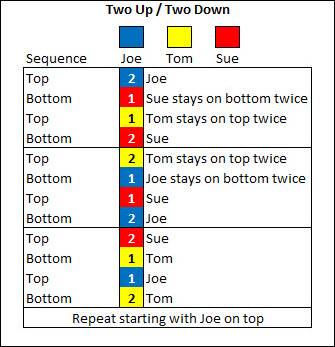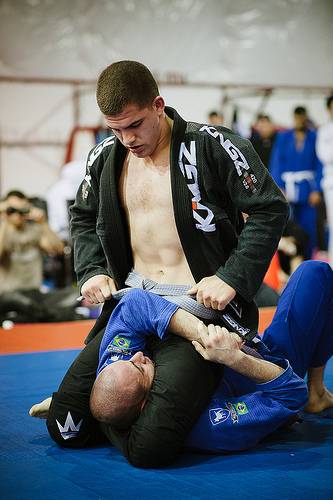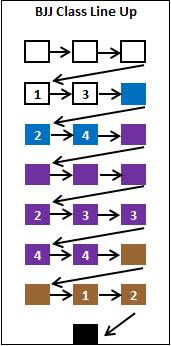Brazilian jiu jitsu is a complex martial art that challenges students both physically and mentally. There are endless techniques and concepts to learn. A simple movement of the hand can be the difference between a choke and a crank. Having your feet in the wrong position could reduce your mobility and reaction speed. It’s hard enough to keep track of these minute details, but that’s not the only difficulty new students face.
My instructor, Kevin Taylor, often says the hardest part of every class is simply lining up at the end to bow out. I also see people struggling to figure out how the Two Up, Two Down system works when the numbers are odd and there’s a group of three partners. (I see your blank looks right now!) And how are new students supposed to know what kind of gi to get if they can’t try them on? What about tying the belt? And where do they buy those awesome Meerkatsu rash guards? Don’t worry boys and girls. I have the answers.
Question #1: What’s the Difference Between Gi and No Gi?
Brazilian jiu jitsu is traditionally practiced in the gi. A gi is a uniform that enables students to practice choking and controlling each other with articles of clothing. It is much more sturdy than your average hoodie or t-shirt and is designed for performance.
In no gi training, students generally wear a rashguard and shorts or spats. The clothing is not used for choking or controlling, and baggy items should be avoided to protect fingers and toes from getting caught up and broken. When I’m training no gi, I try to cover as much skin as possible to prevent skin infections and wardrobe malfunctions. I would prefer to not have a hairy armpit or bare thighs touching my face or neck and I’m sure most people feel the same way, so that’s something to consider when you’re choosing what to wear to class. Generally, no one cares what anyone else actually looks like at BJJ.
Two great places to buy BJJ gear are Roll More and Fighters Market. Roll More offers a sixty-day exchange policy on all gis to ensure you’re happy with your purchase. BJJHQ and MMAHQ offer daily deals on training gear so be sure to sign up to their email list.
Question #2: How Do I Know What Kind of Gi to Get?
Buying a gi sucks if you have no idea what you’re doing. You have to order them online and try to find a gi that suits your style, height, weight, and body type. There are so many companies out there, how would you even know where to start? First, check out Meerkatsu’s gi-buying guide or sign up for Gi Reviews’s Epic Gi Book to figure out what to look for.
Question #3: How Do I Tie My Belt?
I like using a flat, tidy knot for my gi belt. My suggestion is to use the super lock variation of the Hollywood variation demonstrated by Rener Gracie in his belt-tying instructional.
Question #4: How Does a Group of Three Students Take Turns Drilling?
At my gym, we generally use the Two Up, Two Down system for taking turns in technical training and positional drills. This system is illustrated below.

Question #5: How Hard Should I Go in Sparring?
 This is a tricky question. You want to practice what you’ve learned, but you also want to be the kind of person other people enjoy training with. I’m always surprised when a very friendly 200lb guys squashes me during rolling. I think it’s simply a lack of self-awareness. If this happens to you, the best solution is to explain your position to your partner in a polite way – or just avoid rolling with him or her in the future.
This is a tricky question. You want to practice what you’ve learned, but you also want to be the kind of person other people enjoy training with. I’m always surprised when a very friendly 200lb guys squashes me during rolling. I think it’s simply a lack of self-awareness. If this happens to you, the best solution is to explain your position to your partner in a polite way – or just avoid rolling with him or her in the future.
A good way to judge whether you’re being a good partner is to observe your partner’s breathing and facial expression. If your partner is breathing extremely heavily or looking upset and avoiding eye contact, you may want to ask if he or she is okay and lay off a little bit. If you’re much stronger and/or more skilled and you submitted your partner seven times in five minutes, it might be kind to slow down and give him or her an opportunity to practice technique.
The better your partners and teammates become, the better you become. That being said, if you don’t challenge your partners or don’t want to roll with someone who is challenging you, you’re helping no one. As Dean Lister said, you should look at your opponent as your greatest teacher.
Question #6: Why Do YouTube Videos Contradict My Instructor?
There are endless techniques and variations of techniques in BJJ. Your instructor may have shown you the version that works best for him or her, but that doesn’t mean it is the only way a particular technique can be done. Something else to remember is that sometimes an instructor will have extensive knowledge of some techniques but not others due to his or her personal game. Don’t be disappointed if he or she isn’t an expert at every technique in jiu jitsu. One of the things I love about my gym, Titans, is that we have so many skilled practitioners with a variety of specialties. There is always something new to learn from everyone.
If you are looking to hire someone to teach you private lessons, then this is a topic you may want to discuss with him or her. You want to ensure that you are on the same page regarding which techniques you will be focusing on. Otherwise, you may be disappointed to learn that the old school jiu jitsu guy has no interest in working on the berimbolo with you.
Question #7: How Does the Line-Up at the End of Class Work?
At the end of every BJJ class, students line up and bow out to their instructor and fellow teammates. Some schools have a single line, some have two or three. At my club, we have three rows of mats and so we create three lines. The instructor(s) stand at the front of the class and bow us out. Then we all move forward to do an arm drag/handshake/hug/bow and acknowledge each other’s contribution to our training by saying something like “thanks” or “good class.”
 The three lines of students are organized according to rank and seniority in rank. Belts are ranked white, blue, purple, brown, and black. In addition, stripes will often be used to indicate a student’s progression through each of those ranks. As students move forward, they follow in the direction of the student who is next highest in rank. Once the end of the line is reached, the student turns around and begins shaking hands with lower-ranked students. Everyone continues moving forward until everyone has shaken hands with everyone. This situation is illustrated below. The numbers indicate the number of stripes on a student’s belt.
The three lines of students are organized according to rank and seniority in rank. Belts are ranked white, blue, purple, brown, and black. In addition, stripes will often be used to indicate a student’s progression through each of those ranks. As students move forward, they follow in the direction of the student who is next highest in rank. Once the end of the line is reached, the student turns around and begins shaking hands with lower-ranked students. Everyone continues moving forward until everyone has shaken hands with everyone. This situation is illustrated below. The numbers indicate the number of stripes on a student’s belt.
Beginning BJJ can be intimidating, but all of us remember what it was like and if you’ve joined a good club, then other students will want to help you have the best experience possible. They may be shy, though, so it’s always a good idea to speak up and ask for advice or to ask someone to be your partner. Remember, if you’re just sitting there doing nothing, you shouldn’t be. Best of luck and enjoy the journey!
Photos provided by David Brown Photography.






